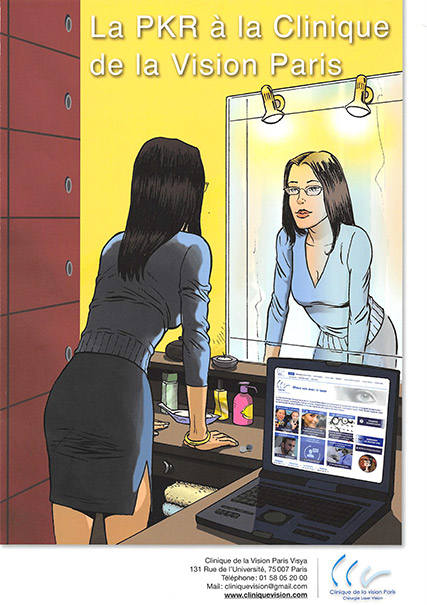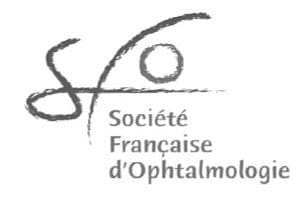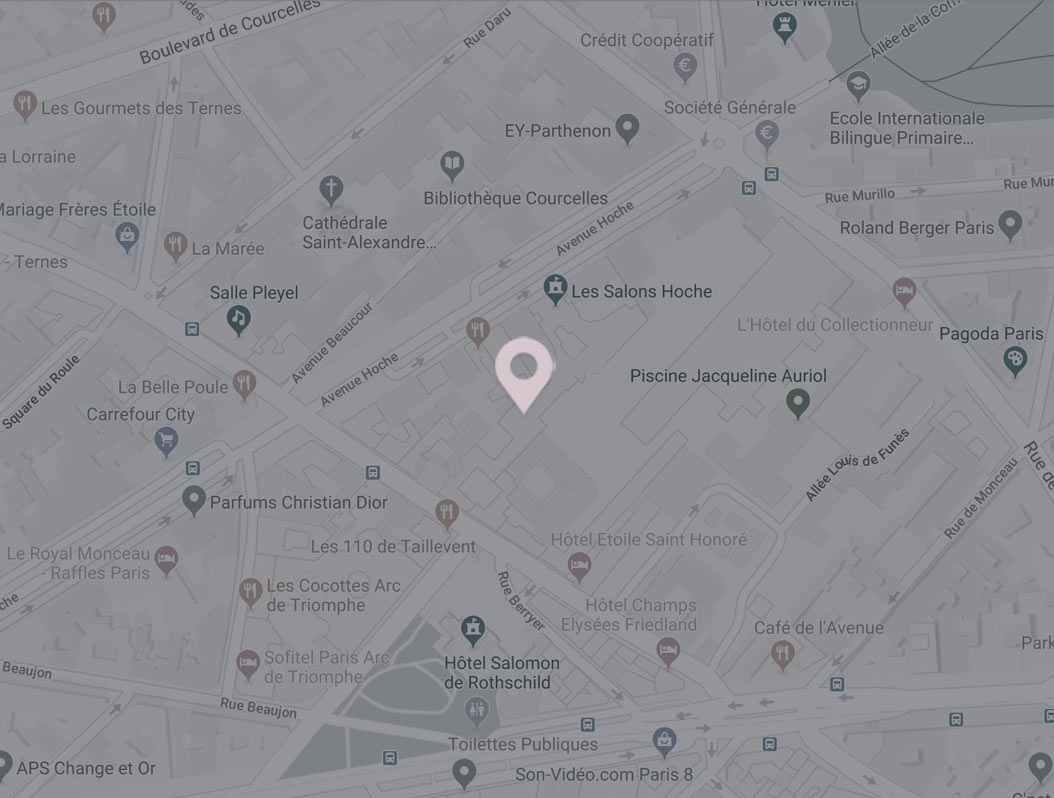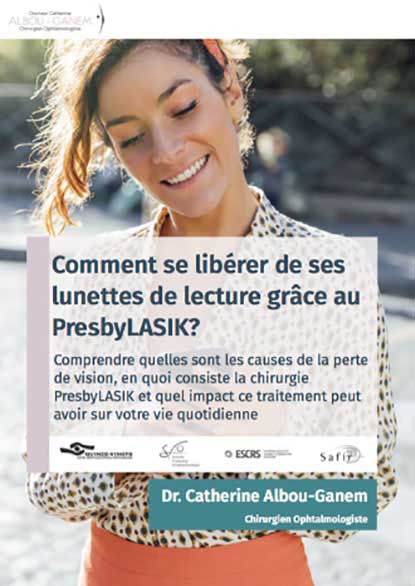PRK
Same results as LASIK, with a broader suitability range
Summary of PRK
- The cornea is the transparent porthole in front of the eye
- Its thickness varies between 450 and 600 microns (a human hair is approximately 50 microns in diameter)
- The more the cornea is “curved”, the higher its dioptric power is necessary and vice versa
- As a result, increased curvature of the cornea corrects hypermetropia and flattening of the cornea corrects myopia
- It is from these principles that, in the sixties, José Barraquer theorized and developed corneal refractive surgery from which modern ophthalmologists derived PRK
- The term PRK is the abbreviation of “Photo Refractive Keratectomy” – keratectomy meaning removing a portion of the cornea
- Ophthalmologists have practised PRK since 1978
- PRK can correct myopia, hyperopia, astigmatism and presbyopia (when used with PRESBYLASIK)
- PRK is a virtually painless procedure performed under anaesthesia by simple instillation of eye drops
- The typical visual recovery after PRK is 7 days
Photo Refractive Keratectomy (PRK) – An introduction
LASIK is a surgical technique that consists of using an Excimer laser to reshape the area of the cornea to modify the radius of curvature and therefore power. In PRK, or “Photo Refractive Keratectomy” (keratectomy means removal of a portion of the cornea), we apply the laser after removing the epithelium (very top layer) of the cornea.
The PRK procedure:
The procedure is quick; it takes less than half an hour for both eyes. We perform PRK under local area anaesthesia by instilling eye drops. PRK is painless. It is not necessary to come on an empty stomach for this type of anaesthesia and intervention.
What conditions does Photo Refractive Keratectomy (PRK) address?
We most often propose PRK when there is a contraindication to intrastromal laser eye surgery (LASIK or SMILE). The contraindications are most often related to the morphology of the cornea, for example, a thin cornea or rough keratoconus.
How do you know PRK is right for you?
Refractive surgery (the type of surgery that PRK is) is for all ametropic patients (short-sighted, long-sighted, and astigmatic) whose glasses or contact lenses offer proper vision correction, but who wish to see clearly without optical accessories.
Refractive surgery is an optional surgery of convenience. It is only for well-informed and motivated patients. The decision to have PRK is personal, and the motivations include comfort, sport, aesthetic or professional.
We use PRK to correct low and medium ametropia provided that there is no contraindication. We will detect any contraindications during the preoperative assessment.
Photo Refractive Keratectomy (PRK) – Further details
The operation takes place in 2 steps:
Step 1: Removal of the epithelium
We take this step by using a scarifier, a brush or alcohol. It lasts a few seconds and is painless because your eyes are numb.
Step 2: Reshaping the cornea
The second step is refractive and corresponds to the corneal remodelling (or photoablation) with the EXCIMER laser. This remodelling is entirely painless but can cause a particular odour due to the evaporation of the corneal tissue. The duration depends on the degree of ametropia to be corrected, but the photoablation does not exceed 1 minute.
Throughout the duration of the laser treatment, you must stare at a light spot. Doing so is not difficult. However, if you stop staring, a safety device (eye-tracker) servo-controlling the laser beam flies into action and will follow the movements of the eyeball or interrupt the treatment if the deviation is too significant.
After the procedure, we place a bandage contact lens that acts as a dressing on the treated area. You must wear the contact lens day and night. Unlike with LASIK or SMILE, you will most likely feel some discomfort for a few days after the procedure as the eye heals. We remove it as soon as the discomfort eases between the 3rd and 4th day.
Post-operative experiences
Once the procedure is over, you’ll have blurry vision for a few hours, but you can move without difficulty. You’ll be able to blink regularly, but we advise you to keep your eyes closed for some time after the procedure. We recommend you wear special goggles until you no longer feel any discomfort.
Your stay in the clinic will not exceed 1 hour. You can go home by private car or taxi, but you cannot drive because of the visual fog. It is better but not necessary to leave the clinic accompanied.
An ocular discomfort with the sensation of “sand in the eye”, accompanied by a more or less abundant tearing and dazzling in the light, appears one hour after the procedure.
This sensation lasts about three days, and many patients feel it most in the first 24 hours. During this period, it is best to close your eyes and avoid too much light.
You can resume work after 4 to 5 days provided you do not work in a dusty environment. Your vision can be blurry for a week. Work stoppages are not possible for this surgery because the government considers it a comfort surgery not supported by Social Security. A postoperative consultation is necessary for the days following the surgery.
Visual Recovery
Surgery for myopia, astigmatism, presbyopia, and hyperopia using the EXCIMER laser is accurate, effective and safe. After the surgery, 98% of patients can lead a fully spectacle-free life after the procedure. Postoperative vision is usually comparable to preoperative corrected vision with glasses or contact lenses.
The degree of satisfaction of the operated patients is close to 100%. Naturally, your happiness will depend on the quality of the surgical procedure and the expertise of the surgeon. Vision recovery requires 12 to 24 hours which allows you to resume your normal activities the day after the procedure.
Screen work does not pose a particular problem, and you are free to engage in it. After the procedure, your vision will be different, and it takes a few weeks to stabilise. During this period your near vision can be temporarily disturbed.
Postoperative precautions
- Do not rub your eyes
- Do not remove the bandage contact lenses before 3 days unless we advise you to do so
- In case of tearing, which can be frequent in the immediate postoperative period, wipe your eye with a clean compress, without touching the eye
Wear the protective eye shields we provide for three nights after the procedure - Begin eye drops on the day of the procedure according to the prescription we give you and for the duration and dosages we prescribe
Post-operatively, in case you experience eye pain, or even discomfort, immediately take a relaxing medication or analgesic. If, the symptoms reappear, consult with us quickly - Do not make any important decisions while under the influence of a tranquillizer
- Showering and shampooing are possible the day after the surgery provided you take the necessary precautions not to rub your eyes
- Resuming work the day after the operation is possible unless the activities of your job involve danger to the eye
- Avoid contact sports for 1 to 3 months. You can resume swimming with your head underwater after 3 weeks
- Do not forget to attend aftercare appointments
- The final definitive glass to prescribe on your eyeglass frames will be only after a few weeks
- Remember to change the details of the driving license
- Tell your treating ophthalmologist that you have had surgery
- Get monitored annually by an ophthalmologist
FAQs about Photo Refractive Keratectomy (PRK)
How effective is PRK?
Effectiveness corresponds to obtaining visual acuity without correction between 5/10 and 10/10. 80% of patients have visual acuity equal to 10/10 without correction, all ametropia combined.
What is the predictability of PRK?
Predictability corresponds to obtaining a correction equal to the correction sought. The laser procedure exceeds 95% predictability.
How safe is PRK?
Safety is the rate of complications. The rate of hazards and complications in laser eye surgery is less than 1%.
We evaluate the final quality of vision after surgery on both eyes after a delay that varies according to the chosen procedure. We see a satisfactory quality of vision in more than 98% of cases. That does not mean getting 10/10 acuity in all cases because individual variations can occur.
The LASIK results are definitive and stable over time.
Uncorrected visual acuity is most often comparable to what we measure with lens or lens correction before surgery.
Sometimes, however, an additional low-power lens or lens correction may be necessary after surgery, especially for difficult visual tasks, such as night driving or reading small print.
That is also the case if under-correction is planned, particularly in myopic patients, in whom it is preferable to under-correct the non-dominant eye so as not to compromise near vision.
What are the side effects of PRK?
Certain immediate postoperative inconveniences follow laser eye surgery:
- The sensation of sand in the eyes, tearing and the inability to keep one’s eyes open last about 3 to 4 days
- The discomfort with reading lasts from a few hours to a few days
Some side effects are common but not universal. These side-effects usually go away after six months:
- Many patients report a decrease in contrast sensitivity, marked by more difficulty of adaptation during the transition from light to dark
- Opalescence of the cornea (corneal haze) in the area of photoablation. This haze is usual and most often does not affect visual acuity. Patients mostly experience haze in the first postoperative month. Haze usually disappears between the 6th and the 12th month
- Some patients experience glare with halos around neon lights and especially headlights
Dry eye is typical for 3 to 6 months postoperatively. We can relieve dry eye symptoms by the prescribing eye drops to lubricate the cornea
TÉMOIGNAGES

“Le jour de l’intervention, je n’ai ressenti aucune gêne et aucune douleur. Après 2 h de repos j’ai pu reprendre mes activités tout à fait normalement. Deux jour après l’intervention il ne subsiste aucune gêne. Je tenais également à insister sur le fait que, contrairement aux idées reçues, ce n’est pas une intervention réservée aux personnes jeunes. J’ai 59 ans et c’est une totale réussite.”

“Le Docteur Albou-Ganem m’a opérée de la presbytie il y a un an, et je suis très heureuse du résultat, plus besoin de lunettes pour lire, même ma vue de loin est bonne. C’est un vrai soulagement pour moi, car j’ai hésité pendant un moment avant de sauter le pas, difficile de prendre une telle décision.”

“Après une opération rapide et sans douleur j’ai quasiment immédiatement remarqué une nette amélioration de ma vue de près et de loin. Au fil des semaines cela n’a fait que se confirmer et je n’ai jamais reporté mes lunettes depuis! Je ressens une telle liberté dans ma vie de tous les jours ainsi qu’une impression d’avoir rajeuni que je recommande à toute personne de le faire sans hésitation si cela leur est possible!”

“Docteur Catherine Albou-Ganem l’a immédiatement dissipée. Contact et confiance se sont installés immédiatement. Ses explications ont été claires, précises et je peux dire que le Jour J de l’opération, j’y suis allé les yeux fermés! Pour les rouvrir quelques heures plus tard avec la vue parfaite d’un homme de 30 ans!”

“L’opération a été un franc succès. J’ai maintenant 10/10e, sachant qu’auparavant j’avais une assez forte myopie (-5 et et -4,5) et un léger astigmatisme.”

“Vous m’avez opérée il y a maintenant plus de deux ans. A part pour conduire et regarder la télévision, et encore… je n’ai plus besoin de lunettes, moi qui n’ai jamais rien vu… Il m’a fallu plusieurs mois pour que ma vue s’adapte. Je tenais donc à vous remercier de cette opération qui a changé ma vie! Plus d’ulcères douloureux dus aux lentilles et la possibilité d’ouvrir les yeux sous l’eau et d’admirer les jolis poissons!”
We have replaced the images of real patients who provided these testimonials to protect their privacy.
 Skip to content
Skip to content









